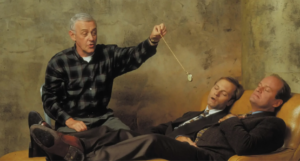Not much is uncontroversial when it comes to the life and work of Sigmund Freud, but one thing ought to be: he was a lousy psychotherapist. Take the case of his patient Horace Frink, who Freud diagnosed with a serious case of latent homosexuality, pressing him to marry his mistress as a cure. Doubtful, but choosing to trust the great man’s judgment, Frink and the woman both abandoned their (devastated) spouses and took his advice. Soon a guilt-ridden Frink turned violent, his new wife demanded a divorce, and he descended into a psychosis punctuated by several suicide attempts.
But then Freud, by his own admission, was much less interested in healing the sick than in pioneering the “science” he called psychoanalysis. So he would have been dismayed to learn that, by the turn of the millennium, most psychiatrists would view his theories in roughly the same way chemists viewed alchemy: as a faintly embarrassing remnant of their field’s unscientific prehistory. “Freud’s ideas”, declared a major history of psychiatry in 1998, “are vanishing like the last snows of winter”. Ironically, Freud’s single surviving legacy in Western medicine looked set to be the use of talk therapies largely cleansed of psychoanalytic content.
This was a brutal demotion in status for a man whose impact was compared, in his lifetime, to that of Darwin. And even if that comparison was Freud’s own, it says a great deal that he wasn’t laughed out of Vienna for making it. Just as Darwin had uncovered the evolution of species by studying the flora and fauna of the Galapagos Islands, Freud believed he had uncovered the evolution of the mind by studying the unhappy patients on his couch. Many eminent contemporaries took him at his own estimation: Einstein wrote him fan mail, and Bertrand Russell campaigned for him to be awarded the Nobel Prize in Medicine. And Freud’s ideas came to hold such sway that through the Seventies the DSM-II, the American “bible” of psychiatric diagnosis, comprised a medley of psychoanalytic terms like “hysterical neurosis” and “schitzoid personality”.
Within a generation, university students were becoming more likely to encounter Freud’s ideas on a course in literary theory than one in psychology or psychiatry. One reason was the new discovery of primary sources which, in the Eighties and Nineties, turned assassinating Freud’s character into something of a public bloodsport among intellectuals. The wise and humble doctor eulogised by Auden now stood accused (irrefutably) of clinical ineptitude and scientific recklessness verging on fraud, (plausibly) of conducting an affair with his wife’s sister, and (absurdly) of attempted murder and child abuse.
But far more damaging for Freud’s ideas was the rise, in the latter half of the 20th century, of an alternative view of mental illness based on three things: genes, brains and drugs. The decoding of the complete human genome promised to unveil the origins of psychological suffering in our parents’ DNA rather than in their care-giving styles. New brain imaging technology would enable us to observe psychiatric disorders in the contours of grey matter rather than rooting around for them in the murk of the unconscious. And new medications to treat mania, psychosis and depression were already replacing the hours of aimless chat prescribed by psychoanalysis. Freud began to look more like the founder of a religion than a scientist, and his followers like disciples zealously but fruitlessly interpreting his sacred texts. “Biomedical” psychiatry had seemingly triumphed; the real scientists would take over from here.
So it may come as a surprise that, decades after the study of the neuroses was replaced by that of the neurotransmitters, a prominent clinical psychologist has published a new book that includes a game attempt to make a scientific case for Freud. In Mortal Secrets: Freud, Vienna and the Making of the Modern Mind, Frank Tallis dares to take a harder line than most other Freudian holdouts. When their discipline came under siege from biomedical psychiatry, most psychoanalysts — turtlenecked figures who could quote Proust and Lacan but had never seen the inside of a lab — retreated to Hampstead, pulled up the drawbridge and turned inward. Adam Phillips, perhaps the most famous of them, now argued that Freud’s ideas cannot be false but, like poetry, only “more or less interesting, more or less inspiring”. Sounding like High Church mystics in the age of modern science, the psychoanalysts in effect helped downgrade their own field from a mighty branch of medicine to a (more inspiring, interesting — and expensive) rival to astrology.
By eschewing such relativism, Tallis may be out of step with contemporary psychiatry — contrast his subtitle with that of the 2006 work Freud: Inventor of the Modern Mind — but unlike Phillips et al., he at least takes Freud seriously on his own terms. After all, Freud fulminated against those like Jung who doubted the literal truth of ideas like penis envy and the oral and anal stages of sexual development. “We don’t reject Copernicus, Kepler or Galileo because they produced horoscopes,” Tallis points out. This is true, but some might object that there is rather more evidence that the earth travels around the sun than there is for the idea that the central trauma of a little boy’s life is his terror of being castrated by his father as punishment for wanting to sleep with his mother.
Boldly (or, perhaps, rashly) Tallis attempts a review of the science. Freud’s ideas, he assures us, have had unspecified “seismic after-effects” in the field of biology. There have been conferences of something called the International Neuropsychoanalysis Society (among whose attendees, we are gravely informed, was Oliver Sacks). In support of Freud’s claim that dreams represent symbolic wish fulfilment, Tallis quotes a neuroscientist who writes that “‘wishing’ might be subserved by the mesocortical-mesolimbic dopamine circuitry of the brain”. There is certainly a pungent, science-y whiff to all this. But readers will decide for themselves whether it adds up to what Tallis calls “Freud’s scientific rehabilitation”.
But perhaps instead a case can be made for the enduring relevance to psychiatry of Freud’s worldview without resorting to scientific credulity or postmodern mystification. Indeed, millions of readers are already familiar with it by way of bestselling books based on a growing body of research on the effects of trauma. When Bessel van der Kolk argues that the human body “keeps the score” of the mind’s suffering, or that “traumatised people have a tendency to superimpose their trauma on everything around them and have trouble deciphering whatever is going on”, he can sound uncannily like Freud (whose work he liberally quotes). Likewise the Canadian physician and intellectual Gabor Mate when he writes that our early experiences can leave us trapped in a “physio-emotional time warp”. Van der Kolk and Mate place strong emphasis on “attachment theory”, first developed by the psychoanalyst John Bowlby, which explores how the effects of our early entanglements reverberate through our lives.
What’s more, the claim that Freud’s notions are unsupported by science no longer cuts as deep as it once did — because, as it turns out, so are some of the fundamental assumptions of the “biomedical” psychiatry that supposedly usurped them. The decoding of the human genome, completed in 2003, did not show that mental illness is predestined but, rather, that hereditary vulnerability interacts with our environment in enormously complex ways. Optimism around psychopharmacology has waned, as new psychiatric drugs have failed to appear and doubts about the efficacy and safety of the old ones has grown. And hopes brain imaging would transform psychiatry have petered out, as new technologies like fMRI have so far shown no utility in the diagnosis or treatment of mental illness. In 2022, a new history of psychiatry gloomily concluded that “biology is a bet whose payoff has been far more limited than its architects promised”.
None of this means that the Gothic edifice of Freud’s theories, with its vaults and gargoyles, is about to be rebuilt. But a sober assessment of what modern psychiatry can and cannot tell us suggests that, in broad outline if not in many of its details, his approach continues to hold much value. Our past loves and terrors can haunt us in the present. We are often opaque to ourselves, riven by conflicts we only half understand, our passions barely kept in check by external constraints. If we can be helped to overcome the thousand ways we protect ourselves from self-knowledge, we may see that our distress is not some random affliction but a meaningful response to the conditions of our development. Our suffering has a story, and it makes sense.
Freud once likened the way we repress unwanted thoughts to the ejection of a disruptive audience member from an academic lecture so that the event can continue smoothly. Now 30 years after Freud himself was manhandled from the podium of psychiatry and shut out of the lecture hall, the authorities who replaced him are faltering — and he can still be heard, banging on the door outside. Even if, as Auden wrote, “often he was wrong and, at times, absurd”, his voice cannot altogether be silenced. Perhaps the most canny assessment of him came from his wronged patient Horace Frink, who when Freud was dying was asked if he had any words for his former idol. “Tell him he was a great man,” said Frink, “even if he did invent psychoanalysis”.
Disclaimer
Some of the posts we share are controversial and we do not necessarily agree with them in the whole extend. Sometimes we agree with the content or part of it but we do not agree with the narration or language. Nevertheless we find them somehow interesting, valuable and/or informative or we share them, because we strongly believe in freedom of speech, free press and journalism. We strongly encourage you to have a critical approach to all the content, do your own research and analysis to build your own opinion.
We would be glad to have your feedback.
Source: UnHerd Read the original article here: https://unherd.com/



